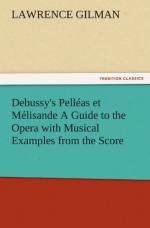XIX
[Illustration: Lent]
[Illustration]
blown across the sea in spring,” says Pelleas, and a horn, accompanied by violins in six parts, announces the motive of Ecstasy (page 245, measure 7):
XX. ECSTASY
[Illustration: Modere]
The ’cellos intone the Melisande theme as Pelleas tells her that he has never seen anyone so beautiful as she; the theme of Ecstasy follows in the strings, horns, and wood-wind, forte; the theme of The Shadows returns as Pelleas again invites her into the darkness beneath the trees; there is a dolorous hint of the Melisande theme as she says that she is happy, yet sad. And then the amorous and caressing quality of the music is sharply altered. There is a harsh and sinister muttering in the double-basses as Pelleas, startled by a distant sound, cries that they are closing the gates of the castle, and that they are shut out. The Golaud motive is recalled with sombre force in the strings as the rattle of the great chains is heard. “All the better! All the better!” cries Melisande; and, as they embrace in sudden abandonment, we hear, introduced by an exquisite interplay of tonalities, the motive of Rapture, announced, pp, by divided strings and flutes (page 258, measure 12):
XXI. RAPTURE
[Illustration: Modere]
As Melisande whispers suddenly to Pelleas that there is some one behind them, a menacing version of the Vengeance theme is played, pp, by the basses, trombones, and timpani. This theme and that of Rapture hasten the music toward its culminating point of intensity. The Pelleas theme is given out by the ’cellos, the Melisande theme (this is not indicated in the piano version) by the violins, and as the lovers embrace desperately, a crescendo leads to a fortissimo proclamation, by all the orchestral forces, of a greatly broadened version of the motive of Ecstasy. As Golaud rushes upon them and strikes down Pelleas, the Fate theme is declaimed by four horns in unison over string tremolos; and, as he turns and silently pursues the fleeing Melisande through the forest, his Vengeance theme brings the act, by a rapid crescendo, to a crashing close.
ACT V
The last act opens with a dolorous phrase derived from the variant of the Melisande theme noted on page 82 of the piano score. It is played by the violas, with harp accompaniment. The violins repeat it, and two flutes announce a new theme (page 268, measure 5), the motive of Pity:
XXII. PITY
[Illustration: Lent et triste]




